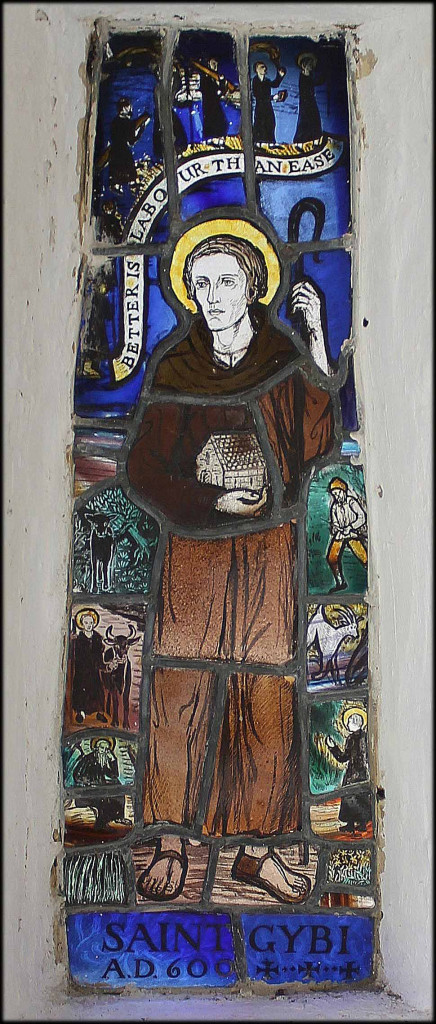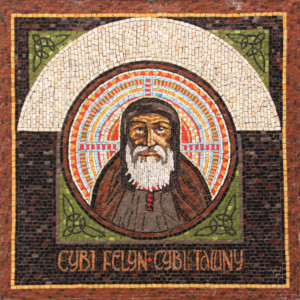The Roman Fort of Caer Gybi.
Perhaps because of St Cybi’s occupation, the external walls of the Roman fort remain almost complete.
As a near complete structure Caer Gybi Roman fort is important. It is unique in that no other example of a three-sided landing place is known in Britain, and is one of only a small number of such forts still existing in Europe. The level of preservation means that it ranks highly alongside examples that include sites in Germany and Hungary. As such, this aspect of the fort’s value imparts a degree of international significance.
The fort was built during the 4thcentury, probably about 350, and remained in use until the end of the Roman occupation. The existing remains are all at cliff top level and form the walls of the upper churchyard, but it is thought the north and south walls originally extended down to sea level, giving a secure area for loading and unloading ships.

Stained glass window of St Cybi at St Bueno’s Church Penmorfa, Gwynedd. Photograph courtesy of Llywelyn 2000, Wikimedia Commons.
In about 450 the Welsh were in conflict with the Irish. There was a decisive battle, known as the battle of Cerrig-y-Gwyddyl, but the precise location of the battle has not been established. The Welsh were led by Cadwallon Lawhir and the Irish were led by their chieftain Serigi Wyddel who stood and fought while others were clambering into boats and escaping. Whilst Serigi was killed in the battle his bravery impressed the Welsh and they buried him, with the respect and honour accorded to a person of his rank, within the grounds of the Roman fort. Victory at Cerrig-y-Gwyddyl was the catalyst which spurred the Welsh on to rout the Irish.
St Cybi’s arrival at Holyhead
It was St Cybi himself who, in about 540, founded a religious community on the site.
The local Lord and Prince, Maelgwyn Gwynedd, granted St Cybi permission to use the then abandoned Roman Fort as a place for a new religious community. It has remained a place of prayer ever since.
St Cybi came to Holyhead after founding other churches in Cornwall, South Wales and on the Lleyn Peninsular. The photograph is of the window at St Bueno’s Church, Penmorfa, just outside Porthmadoc, about 10 miles from Llangybi where St Cybi founded a church. There is still a church there, together with a Holy Well.
St Cybiestablished an important Celtic Christian monastery or Clâs within the Roman fort, His disciples eventually left him to establish their centres in other parts of Anglesey, notably Cyngar to Llangefni and Maelog to Llanfaelog.
A clâs was normally a single building. The building was run by a community of clergy and headed by an abod. Clasau were autonomous and were administered locally. In his book “Anglesey Churches” Geraint I. L. Jones indicates a Clâs was a traditional Celtic monastery church which functioned as a mother church with a number of associated subsidiary churches, e.g. St Cybi, Holyhead, and Llaneilian. The Clâs system was not favoured by the Normans who sought to disband it and replace it with continental style monasteries.
We know that St Cybi’s was the mother church to Bodedern, Bodwrog and Llandrygarn, all on Anglesey.
Whilst, as indicated, it was the local ruler Maelgwn Gwynedd who granted Cybi the use of the abandoned Roman Fort we do not know what else was included in the agreement between them. Did the Prince provide additional protection or support? Was Cybi required to provide prayers for the Prince’s Soul or to pay some form of rent for the use of the Fort? We do not know.
Allowing Cybi to use the Fort may have been of advantage to Maelgwyn. Prominent structures like the Fort were, at the time, seen as a rallying point and, by rivals, as a threat. Allowing the church to occupy the site was a clear indication that the place was not intended to be, or represent, any threat.
Maelgwn was the son of Cadwallon Lawhir who had slain Seirigi at the battle of Cerrig-y-Gwyddyl. Seirgi’s remains were buried within the fort – Maelgwn would have been aware of this.
Maelgwn must have had a complex character. If the chronicles and histories are to believed he was a powerful ruler, with a deep religious faith but also capable of atrocities.
On the one hand Maelgwn was a generous supporter of Christianity, funding the foundation of churches throughout Wales and even far beyond the bounds of his own kingdom. As well as his support for St Cybi he made donations to support Saint Brynach in Dyfed, Saint Cadoc in Gwynllwg, Saint Padarn in Ceredigion, and Saint Tydecho in Powys
Nonetheless, his principal legacy today is the scathing account of his behavior recorded in De excidio et conquestu Britanniaeby Gildas, who considered Maelgwn a usurper and reprobate.
It is said of Maelgwyn that: as a youth, he “dispatched his uncle the king with sword and spear”. Soon afterward, he repented his wickedness and entered a monastery, vowing to remain a monk forever. But later, he violated that oath and returned to his evil ways. After leaving the monastery, he took a wife, then after enjoying his wife “for some little time”, he spurned her and sought another. The object of his affections was a young lady already married to his nephew. To have that lady, he killed her husband and his own lawful wife.
Dynastic connections
Cybi’s Clâs was in close association with Bangor and with the monastery of his friend Seiriol at Penmon and Ynys Seiriol, or Puffin Island. His friendship with Seiriol gave rise to the legend of their walks to meet each other at the Holy Wells of Clorach near Llanerchymedd. They would meet to talk and pray in the middle of the day. Cybi’s morning journey eastwards and afternoon return journey westwards kept his face to the sun, giving him a tan. Seiriol was in the shade with his journeys the other way, so remained pale. They were then known as ‘Seiriol Wyn a Chybi Felin,’ – White Seiriol and Tawny Cybi.

A mosaic of St Cybi, alluding to the story of his walks to meet St Seiriol, by Gary Drostle on the Celtic Gateway bridge in Holyhead.
In Cybi’s time the name ‘saint’ was given to a person who devoted his or her life completely to serving God
St Cybi was contemporary with many of the Celtic Saints, several of whom were related. From his family tree we learn his relations included St Illtud; St Tyfrydog; St Diheufer; St Tyrnog; St Tudur; St Marchell; St Iestyn; St Constantine and St Cyngar.
Within the Ministry Area is the church of St Gwenfaen, Rhoscolyn. This church is said to have been founded in 630 AD and dedicated to St Gwenfaen, daughter of Pawl Hen of Manaw (Isle of Man) and sister to Peulan, (Llanbeulan near Rhosneigr), who built her cloister at Rhoscolyn.
Her brother, Peulan was a follower of Cybi, said to have travelled with him from Cornwall, and is reputed to have founded the church dedicated to him at Rhosneigr. Peulan is said to have been one of Cybi’s twelve “seamen” forming his “family”. Gwyngeneu was another brother who was commemorated with a church at Four Mile Bridge on Holy Island which no longer exists.
In 545 St Cybi was present at the Synod of Llanddewi Brefi, when the subject of the rules of penance was being discussed. Also present were St David and St Deiniol. The synod was apparently called in order to condemn the heretical teachings of Pelagius, although this is far from certain. It was an important milestone in the rise of Saint David. The story goes that Saint Paulinus persuaded Saint Dubricius, the senior bishop there, to allow David, a minor abbot, to address the crowd. His words were so eloquent that Dubricius retired in David’s favour. One of his first duties was to consecrate Saint Deiniol as Bishop of Bangor. At the Synod Cybi gave advice to priests hoping to travel to Bardsey, reassuring them that if their faith was strong, they would be protected against Saxon pirates.
St Cybi died here in 554 and was buried in the churchyard.
The monks’ dwellings and barns have long gone with the development of the town. A large building, probably a tithe barn, was known to be in what is now Swift Square at the end of the seventeenth century. A good deal of that surrounding land was Church property at that time – ‘Glebe’ plots.
St Elbod, and a move towards the Roman Church.

Saint Elbod persuaded the Celtic church to adopt the Church in Rome’s method of calculating the date of Easter.
In 778 there was another important development in the history of the Welsh Church, when the Welsh churches agreed to adopt the date for Easter used by the Church of Rome. Indirectly St Cybi’s was involved in this decision.
It was Saint Elbod (also known as Elfod, or Elfoddw) who eventually persuaded the Welsh bishops to agree to the change. In the Lives of the British Saints, S Baring-Gould, MA, says this was the one really important revolution in the Welsh Church from the fifth to the twelfth century.
Elbod was associated with the monastery at Holyhead as a young man. In the Iolo MSShe is described as “Archbishop of all Gwynedd”, and also as “Bishop of Caer Gybi,” or Holyhead, where “the Archbishops of Gwynedd resided until S. Elfod removed the site and went to Bangor Fawr in Uwch Conwy.”
Later Elbod became Bishop of Bangor. Among his disciples was Nennius, the author of the Historia Britonnum, a purported history of the indigenous British (Brittonic) people that was written around 828. The work was the “single most important source used by Geoffrey of Monmouthin creating his Historia Regum Britanniae” and via the enormous popularity of the latter work, this version of the earlier history of Britain, including the Trojan origin tradition, would be incorporated into subsequent chroniclesfor the long-running history of the land, for example the Middle EnglishBrut of England, also known as The Chronicles of England.
Invasion.
In 961 the settlement was sacked by Viking invaders. The annals record that in 961 the sons of Abloec ravaged Caer Gybi and Lleyn. Abloec is reference to Óláfr Cuaran, ruler of Dublin.
During this period attack from the sea was a constant threat. Raiders targeted churches as they were seen as centres of wealth. As well as the better documented raids on Saxon England there were many raids all along the Welsh coast, including several in Anglesey.
Anglesey, was a particular target for Hiberno-Norse aggression, so close to the Norse settlement at Dublin. Anglesey was attractive to the raiders being the location of the monastic establishments of Penmon, Ynys Seiriol and Caer Gybi, and, as Giraldus Cambrensis states in his Descripto Kambriae, “Just as, for instance, Mount Snowdon could produce pasture for all the herds of Wales , thus the isle of Mona [Anglesey] is so fertile in wheat and meadows to be able to supply produce for some time for the whole of Wales.”
During these raids the Vikings would burn and pillage, stealing treasures, food and animals and capturing men women and children to be sold into slavery.